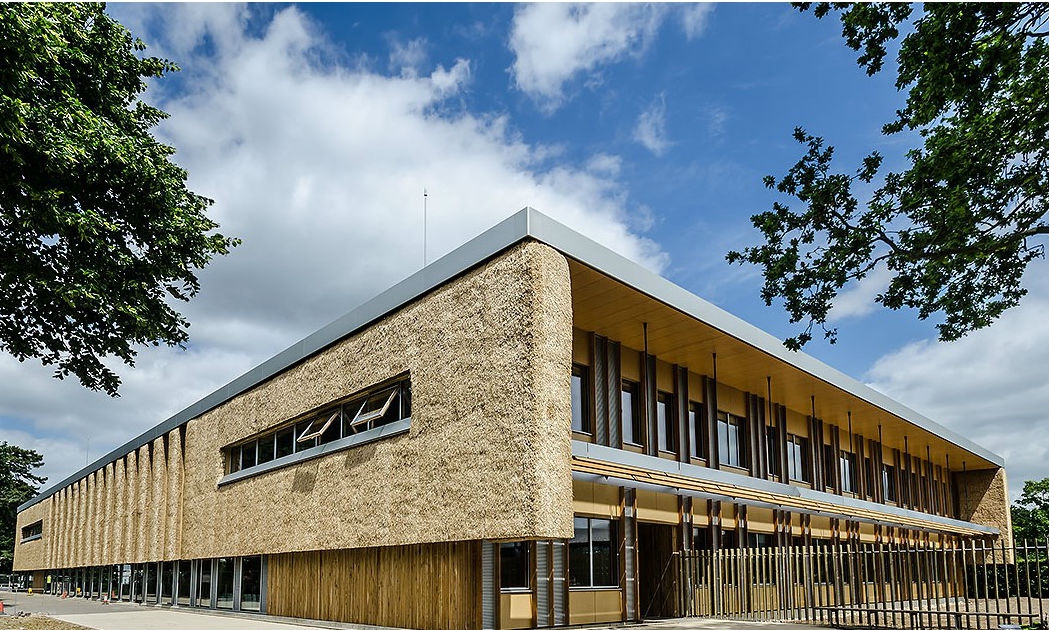The Enterprise Centre at the University of East Anglia is open for business following the completion of work on the highly innovative building, which sets the standard for sustainability.
The building forms a new gateway to the University and has achieved record-breaking sustainability credentials. It is one of the first buildings to target both BREEAM Outstanding and Passivhaus accreditation. It exemplifies the use of low embodied carbon materials and is designed to achieve a 100-year life span.
The vision was developed by the Adapt Low Carbon Group and delivered by Morgan Sindall plc, with a team including architects and Passivhaus designers Architype, structural and building services engineers BDP, and Churchman Landscape Architects.
Completed in June, the building features an innovation lab, a 300-seat lecture theatre, flexible workspaces, teaching and learning facilities, as well as business hatcheries and incubator units for SMEs and start-ups in the low carbon sector. By placing academic and commercial users side by side, the centre’s purpose is to foster innovation, stimulate smarter ways of working, promote industry standards and create new supply chains.
John French, CEO of the Adapt Low Carbon Group and Project Director for The Enterprise Centre, said: ‘I’m delighted with The Enterprise Centre and the finalised building. It’s finished to a beautifully high standard with many stunning features. The whole project has been somewhat of a labour of love for so many people involved across the whole project team and the extent of the innovative and environmentally sound initiatives and products which have been so enthusiastically adopted has been fantastic. The Adapt Group and UEA are very grateful to everyone involved.”
Gavin Napper, Morgan Sindall area director, said: “It’s been a great privilege to lead the project team on this pioneering scheme. The whole team has achieved industry-leading standards on this project and we’re incredibly proud of the collaborative, innovative, and resourceful approach, which they’ve taken from design inception to completion.
“This is a building which is deeply rooted in its surroundings. Our team’s commitment to using indigenous materials, like reed, clay, chalk and hemp, coupled with its focus on utilising local suppliers, contractors and craftspeople, gives the building a real sense of identity and enhances its connection to Norfolk. It’s been great to be able to harness these talents, skills, and products and merge them with the most current sustainable technologies and techniques to create this truly remarkable building which will play a valuable role in driving forward innovation in the region.”
Ben Humphries, Director of Architype and Client Supervisor, said: “With a deep-rooted history and passion for genuinely sustainable design, we have been delighted to be involved in this collaborative, ground-breaking Passivhaus project. Visionary in its brief, we have responded with a design that has pushed at the boundaries of traditional approaches, and with the commitment and dedication of the site team, believe we have achieved a building that sets new benchmarks not only for the university but also the wider construction industry. With an on-going soft landings programme and three years of post-occupancy evaluation to come, we look forward to optimising the building performance for Adapt and the University.”
The building features a number of ‘world-firsts’; key among these is the use of prefabricated and vertically hung straw thatch panel cassettes, which have been used to clad the building. The straw was sourced locally, to fill timber cassette modules off-site in barns across Norfolk. The prefabricated thatch cassette panels were erected onto the façade of the building, creating a striking, and highly innovative sustainable envelope.
Contributing to the building’s low carbon environmental credentials is the Corsican Pine stud work, locally sourced from Thetford Forest, situated 30 miles from the site. Working closely with Cygnum Timber Frame, The Forestry Commission and Thomson Saw Mill, the design and construction teams worked tirelessly to prove the suitability of the timber, generally not used in construction, for structural elements of the building.
Overall the embodied carbon of the building has been calculated to be 440kg/CO2/sqm across the 100-year life cycle. This equates to a quarter of the lifetime emissions of a conventionally constructed university building of equal size and scale. Other innovations used to achieve this include the use of a recycled sub-base from a local demolition project and a 70% ground granulated blast furnace mix (GGBS) as a cement replacement for the building’s ground floor slab.
Underpinning all this has been a commitment by the whole team to create solutions that have been complementary to the rigorous requirements of Passivhaus as well as BREEAM outstanding. On target to achieve Passivhaus with a final airtightness test of 0.21ach@50pascals, the building also features 480m2 solar panels, which are predicted to generate 43.58 MWh in the first year.
A three-year post occupancy and building performance evaluation programme has been implemented with contributions from all team members to assist the occupiers to operate their building optimally and ensure the building performs as designed.
The project is also supporting innovation in the construction sector across the East of England, by helping professionals in the sector to understand how to design, build and operate class leading buildings such as The Enterprise Centre. The scheme is looking to assist over 300 small and medium sized companies with advice, bespoke support, practical tours and demonstrations. Other outcomes from the project will include over 200 jobs created or safeguarded, 35 businesses locating to eco-efficient high quality workspaces, which will be supplied with low carbon energy, and 200 businesses integrating new products, processes or services. The project is gathering national exposure with it being featured at the National Passivhaus 2014 Conference, ECOBUILD 2015 and the Vision 2015 events.
The scheme is being supported by the University of East Anglia, The European Regional Development Fund, Biotechnology and Biological Sciences Research Council, the Buildings Research Establishment and the New Anglia Local Enterprise Partnership (NALEP).
For more information please contact Ruth Cobban email This email address is being protected from spambots. You need JavaScript enabled to view it.


